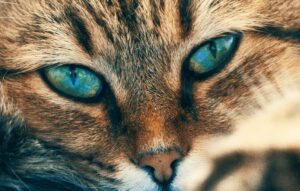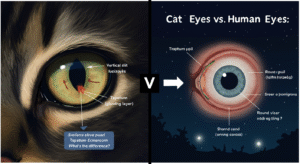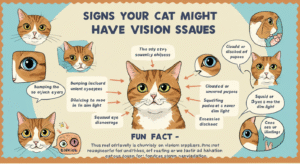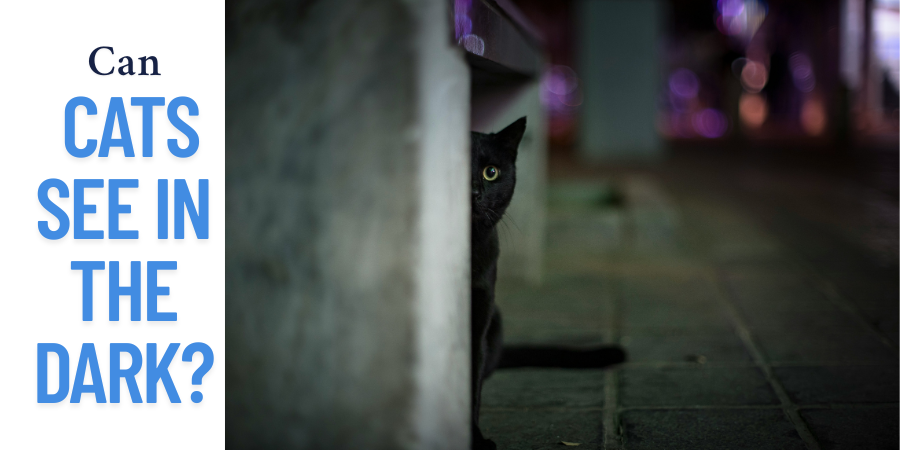Cats are known for their night-time antics and hyperactive zoomies, especially around 3 a.m. Many cat owners are woken by their four-legged feline companion running through the house or delivering gifts like a sock or mouse. These bumps and crashes make people believe cats are nocturnal with excellent night vision. But in truth, felines are crepuscular—more active at dawn and dusk. A cat’s night vision isn’t perfect, but it’s intelligent and well-adapted for low light. Compared to average humans, cats’ eyes and super senses help them see better in the dark than in daylight.
Cats can sniff out their favourite catnip toy from paces away and hear the cat food cupboard opening from the streets. While kitties may not be truly nocturnal, their vision and behaviour show why they’re such notorious night owls. This post will explain how cats see, when they’re most active, and how their eyesight compares to ours.
Contents
- 1 Can Cats See in the Dark?
- 1.1 How Cats’ Eyes Work at Night
- 1.2 Cat Eyes vs. Human Eyes: What’s the Difference?
- 1.3 Facts about cats’ eyes
- 1.4 2. Cats are red/green colour blind
- 1.5 3. Cats’ eyes are very sensitive to movement
- 1.6 4. Cats are mid-sighted
- 1.7 5. Cats have great peripheral vision
- 1.8 Signs Your Cat Might Have Vision Issues
- 1.9 Tips to Make Your Home Safer for Your Cat at Night
Can Cats See in the Dark?
How Cats’ Eyes Work at Night
I’ve always been fascinated by how my cat moves so confidently at night, especially when my own eyes struggle to adjust in dim conditions. If you’ve ever tried walking through your people’s homes in the dark, you’ll understand why it amazes me that cats seem to roam without hesitation. While they may not function in complete darkness, their vision thrives in low-light situations thanks to how their eyes are built. When you notice your cat’s eye, especially in the early day or late dusk, you’ll see large, slit pupils that allow more light to enter. These pupils, about 50% larger than humans’, close tightly during the day to prevent light from flooding their vision.

What truly amazed me was learning about the tapetum, a layer of reflective tissue at the back of the eye, which reflects incoming light and sends it back to the retina. This not only helps bring more light in but also makes their extra light usage incredibly efficient. In the wild or even at home, this system supports their instinct to hunt small animals or prey during dawn and dusk. While many assume cats are nocturnal, they are crepuscular, most active at a time of day when their biological design gives them the upper hand.
Cat Eyes vs. Human Eyes: What’s the Difference?
I’ve always admired how cats seem to effortlessly see in the dark, especially compared to us pet parents. While the human’s round pupils react slower, a kitty’s vertically slit pupils rapidly constrict in bright sunlight and dilate as evening arrives. The strategic shape and movement of a cat’s eyes give them powerful vision, especially in low light. Watch them in morning sunlight or evening—you’ll notice how their pupils constrict and then pupils dilate, adapting almost magically. This flexibility makes it easier to view the world in shades of gray, an ideal trait when the surroundings are dim.

As a vet, I’ve studied the advantage of vertically slit pupils—how they alter the intensity of light hitting the retina by 135-fold, compared to only tenfold in a human with circular pupils. While kitties see better in the dark, humans still hold the edge in visual acuity. According to Dr. Richard E. Goldstein, chief medical officer at the Animal Medical Center in New York City, cited by the New York Times, this big advantage in night vision lies in how effectively slit pupils respond to light as it enters their eyes. Though humans may enjoy clearer vision in bright conditions—as noted by Business Insider—our furry friends dominate when the lights dim. The combined visual abilities of people and their feline friend make a perfect team, balancing clearness of vision with exceptional night vision. As a pet lover, if you are worried about your cat at work, here are the details about how to Keep Your Cat Entertained While at Work.
Facts about cats’ eyes
When it comes to the fascinating world of feline vision, the facts about cats’ eyes reveal a blend of mystery, precision, and natural design that outshines what humans experience daily.
1. Cats have good low-light vision
It’s often believed that cats can see in absolutely no light, but that’s not quite true. What sets them apart is how their eyes adapt in low-light conditions—like a quiet moonlit night—where they perform six to eight times better than ours. Their pupils, the black bits of the eye, expand wider, allowing more light in, and specialized rods in the retina, which are highly sensitive to light, give them this edge.
There’s also a reflective layer of tissue in their eyes called the tapetum that reflects light back to the rod cells, helping them absorb more light. That eerie glow when light shines—whether from car headlights or a camera flash—is no accident. Their sharp eyesight at night often gets them labeled as nocturnal, but in truth, they’re crepuscular, most active at dawn and dusk, ready to hunt prey, dash around the house, or demand breakfast like clockwork.
2. Cats are red/green colour blind
While human eyes are equipped with three colour receptors or cones to process a full rainbow of colours, cats navigate the visual world a bit differently. They have fewer cones, just two types, which limits the range of colours they can see. From my years photographing pets, I’ve noticed how cats react more to contrast and shape than to vivid tones.
To them, red and green appear as muted shades of grey, while blue and yellow stand out more clearly. Instead of colour richness, cats rely heavily on brightness for viewing and seeing their surroundings. Their perception is less about hue and more about how light dances across the room, which explains their laser focus on movement, even in dim light
3. Cats’ eyes are very sensitive to movement
What truly sets cats apart as natural hunters is how incredibly sensitive their eyes are to even the slightest movement. I’ve seen my own cat freeze mid-step just to detect a flicker across the floor—whether it’s a bug or one of those quick-moving toys, nothing escapes that gaze.
They can pick up objects moving at fast speeds, allowing them to locate and pounce with impressive precision. This instinctive ability makes playtime look effortless, but behind the ease is a visual system tuned for survival.
4. Cats are mid-sighted
Unlike humans, cats lack certain muscles to adjust the shape of their eyes, which limits their ability to focus on objects up close. I’ve often noticed how my cat sniffs a toy near his nose rather than trying to see it clearly, relying instead on his whiskers to detect what’s right in front of him.
Though not particularly good at seeing far away, their vision is sharpest when viewing things from about 20 feet (or six metres)—far less than our 100 to 200 feet (30 to 60 metres) range. This small range of sharp, middle vision is why they’re known as mid-sighted hunters, tuned for just the right distance to stalk and strike their target.
5. Cats have great peripheral vision
One of the reasons cats react so quickly to sudden movement is because they have a much wider field of view than our own. While we can see up to 180 degrees, their range extends to 200 degrees, with about 30 degrees on each side, allowing them to pick up on anything approaching silently.
I’ve often seen my cat suddenly turn his head before I even notice a shift—he can easily spot hidden threats or unnoticed objects of interest sliding in from the side, an advantage nature has finely tuned into feline survival.
Signs Your Cat Might Have Vision Issues
Many cat parents often reach out to veterinary ophthalmologists asking how to tell if their cat might be going blind. While the reasons causing blindness can vary, the real concern lies in noticing early symptoms and knowing what to look for when your feline is experiencing vision problems, especially in low light situations.

Below are some signs to watch for if you’re concerned about your cat’s eyes:
- Uneven, wide pupils
- Changes in the appearance of the eye, including cloudy eyes
- Disorientation or bumping into objects, particularly in dim light
- Walking slowly, cautiously, with legs held wider apart than usual
- Hugging the wall to walk, using it as a guide
- Problems finding familiar items like food bowls and litter trays
- Not wanting to go out at night, especially if they usually roam outdoors
- Behavioral changes like hiding, seeming nervous
- Reluctance to jump or misjudging distances
Tips to Make Your Home Safer for Your Cat at Night
To truly cat proof your home, you need to think like a cat—imagine leaping across furniture, fixtures, and playing “the floor is lava” through the room, where every surface looks like a place to jump or hide. Even at just 10 lbs, with a body like liquid, they’ll explore under beds, behind sofas, around dressers, or inside buffets, and their curiosity draws them to area rugs, fireplaces, and bookshelves, sniffing out things to be explored with paws or teeth.
Here is a list of Tips to Make Your Home Safer for Your Cat at Night
- Secure all bookshelves, tall furniture, and shelves to the wall to prevent tipping during nighttime climbing.
- Loop and tie long, dangling blind or curtain cords that could entangle or even strangle cats if they decide to play.
- Put away all breakable, fragile, or glass valuables on surfaces like countertops, especially if they can be swatted or knocked off.
- Check your windows and doors—ensure screens and latches are secure to avoid accidental escape or blocked ventilation.
- Keep all household chemicals, cleaners, detergents, and anything harmful in closed, inaccessible storage spaces to avoid ingestion or poison risk.
- Protect electrical cords and wires from chewing or shock by bundling, hiding, or unplugging them, especially around kittens.
- Make sure none of your indoor plants are toxic—some like lilies may look like harmless decorative foliage but can be deadly. Always consult your vet and identify what needs to be removed.

